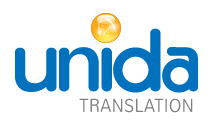Managing translation costs efficiently requires thoughtful planning and a strategic approach. As more organizations, institutions, and public agencies are required to produce multilingual content for compliance, outreach, or accessibility, translation budgets are often limited or fixed. Making informed decisions about allocating resources can substantially affect long-term efficiency and overall cost.
1. Prioritize Content That Has a Clear Purpose
Every translation should fulfill a clearly defined purpose–operational, legal, or communication. If documents are selected for translation without careful review, organizations incur unnecessary costs when including outdated, irrelevant, or redundant material.
Before submitting documents for translation, it is helpful to review them in order to confirm relevance. Outdated drafts, legacy files, or internal communications often provide little value outside their original context. Eliminating unnecessary content from the translation queue reduces volume and ensures that resources are directed where they matter most.
Tip: Create a checklist to assess each file’s current importance, audience, and alignment with business goals before sending it for translation.
2. Leverage Translation Memory to Reduce Repetition
A powerful way to reduce translation costs over time is to use translation memory systems. Translation Memory (TM) refers to a digital database that stores previously translated text, allowing it to be reused in future projects. This method supports consistency across large volumes of content and reduces the time required for new translation work.
Organizations with recurring documents–such as contracts, training manuals, safety procedures, or compliance reports benefit most. TM helps ensure that frequently used phrases and industry-specific terms are translated uniformly every time, reducing workload, turnaround time, and overall cost.
3. Provide Context for Accurate Translations
Accurate translations depend on context. Translators need to understand the original document’s intent, tone, and audience to deliver work that requires fewer revisions, improving outcomes and saving both time and money.
For example, if a document is intended for a public audience, the language might require a more informal style than internal communications or technical specifications. If the material is legally binding, the translator must follow strict conventions regarding structure and terminology. In all cases, context allows the translator to select appropriate phrasing, formatting, and grammar based on audience expectations.
Unida Translation encourages its clients to submit reference materials whenever possible. Style guides, glossaries, sample translations, and explanatory notes can distinguish between a translation needing correction and one ready for use. Whether it’s a marketing brochure, technical document, or legal contract, the right context leads to better outcomes.
4. Work with Certified Translators and Language Professionals
Certified translators bring the qualifications, training, and subject-matter expertise needed to handle sensitive or specialized content precisely. Their deep understanding of legal, medical, financial, and governmental language reduces the likelihood of mistakes, omissions, or terminology inconsistencies that could result in costly and time-consuming revisions.
Working with language professionals helps organizations maintain credibility with stakeholders, government agencies, and industry partners. Certified translation carries an assurance of accuracy, which is particularly important in environments where language use may affect liability, compliance, or legal standing.
At Unida Translation, all our language professionals hold recognized certifications and follow documented quality assurance protocols. This level of preparation and oversight supports accurate delivery while helping clients avoid delays caused by errors or unclear phrasing.
5. Plan Ahead to Avoid Rush Fees
Planning translation projects provides measurable financial advantages. While translation providers can respond to urgent requests, short timelines require allocating extra resources, extended working hours, or expedited review processes. These factors contribute to a higher overall cost.
Organizations that plan translation projects with realistic deadlines enjoy greater flexibility, better scheduling, and more favorable pricing. Planning enables providers to assign the most suitable translator, follow standard quality assurance procedures, and deliver the final product without delay. This structured pace promotes both accuracy and savings.
In sectors where accuracy is tied to compliance or liability, avoiding rushed translation can prevent costly complications later. Reliable timelines ensure the translated material is correct on the first submission and accepted without further revision.
6. Submit Well-Formatted and Editable Files
Translation is more efficient when the content follows a clear structure. Well-organized, clean, editable files support faster analysis, allow translators to focus on meaning without distraction, and eliminate delays caused by ambiguity or poor formatting.
Organizational planning begins with content formatting. Documents should be submitted in an editable format, with a clean layout that minimizes unnecessary design elements or scanned images. This improves processing speed and reduces the need for time-consuming pre-translation steps. In cases where technical terminology is used, such as in legal or production documents, consistency in word choice across files significantly streamlines the translator’s workflow.
Grouping files by topic or document type in translation projects involving multiple departments or content categories improves workflow efficiency. For example, internal policy documents should remain separate from legal contracts, and product manuals should be isolated from marketing materials. Each category requires different linguistic strategies, which are easier to apply when documents are sorted accordingly.
7. Build Long-Term Relationships with Trusted Providers
Consistency matters in translation. Working with the same provider across multiple projects creates long-term benefits: translators become familiar with the brand voice, industry terms, internal preferences, and formatting requirements. This knowledge results in more accurate translations, faster turnaround, and fewer revisions.
Establishing continuity in service also allows for customized workflows that align with the client’s typical document structure and communication style. Language providers become familiar with content trends, brand tone, and formatting expectations. These details, while small, support stronger consistency across all translated material.
Changing providers frequently interrupts this continuity, increases onboarding time, and resets the learning curve. By establishing a lasting relationship with a trusted provider, clients can eliminate many inefficiencies that lead to higher translation costs.
8. Align Translation Projects with Communication Strategy Relationships with Trusted Providers
Translation projects achieve the most value when they support broader communication, compliance, and public access goals. When translation work aligns with strategic priorities such as regulatory approval, stakeholder engagement, or service accessibility, organizations avoid spending on materials with limited reach or utility.
Reviewing communication priorities before initiating translation ensures that only necessary materials receive attention. It also helps allocate budget to content that delivers measurable results. For example, translating a client-facing document is more urgent than translating internal materials. Similarly, translating high-traffic digital content can produce better returns than technical appendices receiving little engagement.
9. Why Choose Unida Translation for Your Language Needs?
At Unida Translation we understand that every project is different and that your budget matters. That’s why we offer translation services grounded in accuracy, efficiency, and transparency.
Unida Translation provides expert translation services in over 125 languages for both official documents and informal content. Our certified translators and interpreters specialize in legal, medical, financial, governmental, and operational fields, delivering accurate and culturally appropriate results. We are proud to be certified as a Minority Business Enterprise (MBE) by the Chicago Minority Supplier Development Council, as a Minority and Women’s Business Enterprise (M/WBE) by the Indiana Department of Administration, and as a Disadvantaged Business Enterprise (DBE) by the Indiana Department of Transportation.
Let Unida Translation help you plan smarter, save more, and deliver high-quality, accurate translations–on time and on budget. Contact us today to schedule a consultation or to request a quote.

